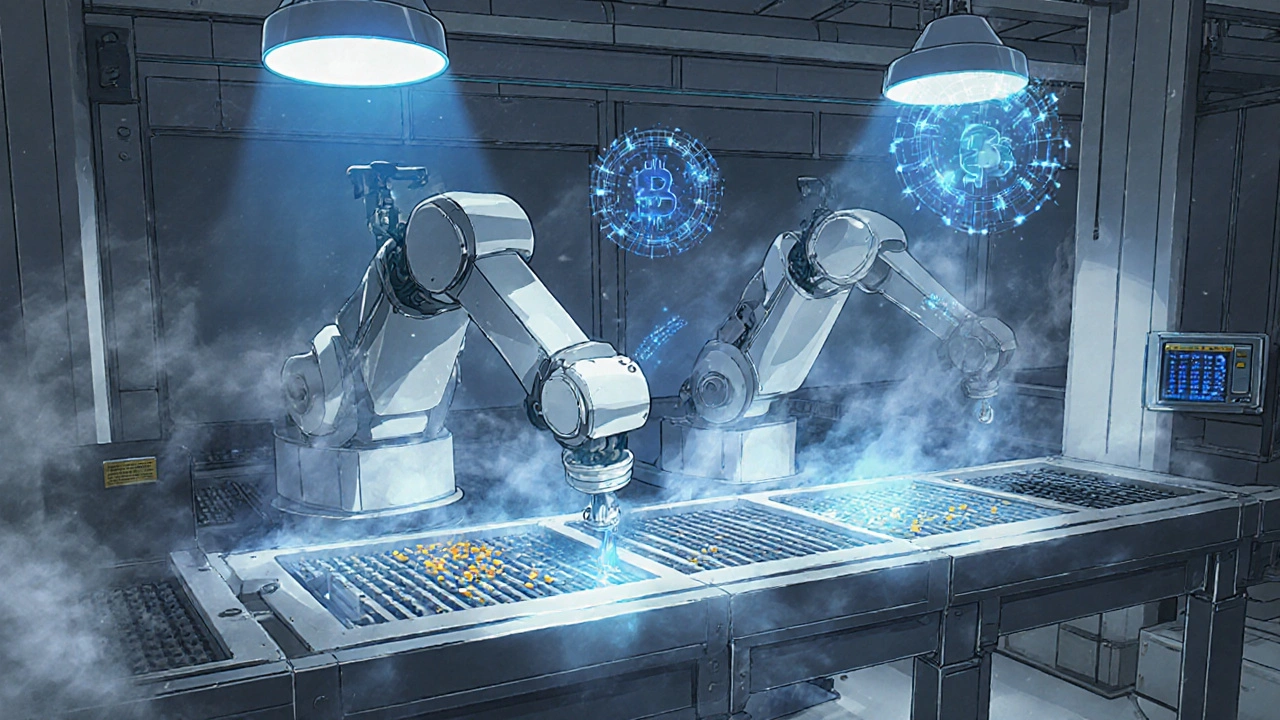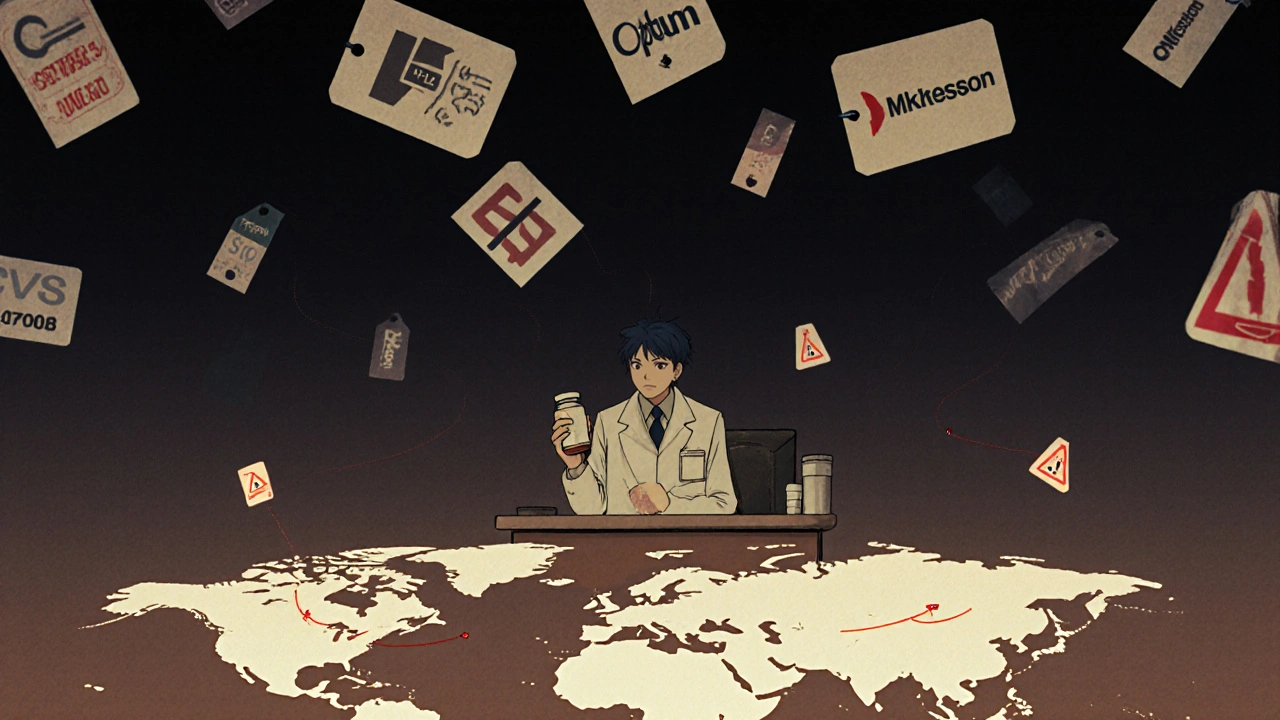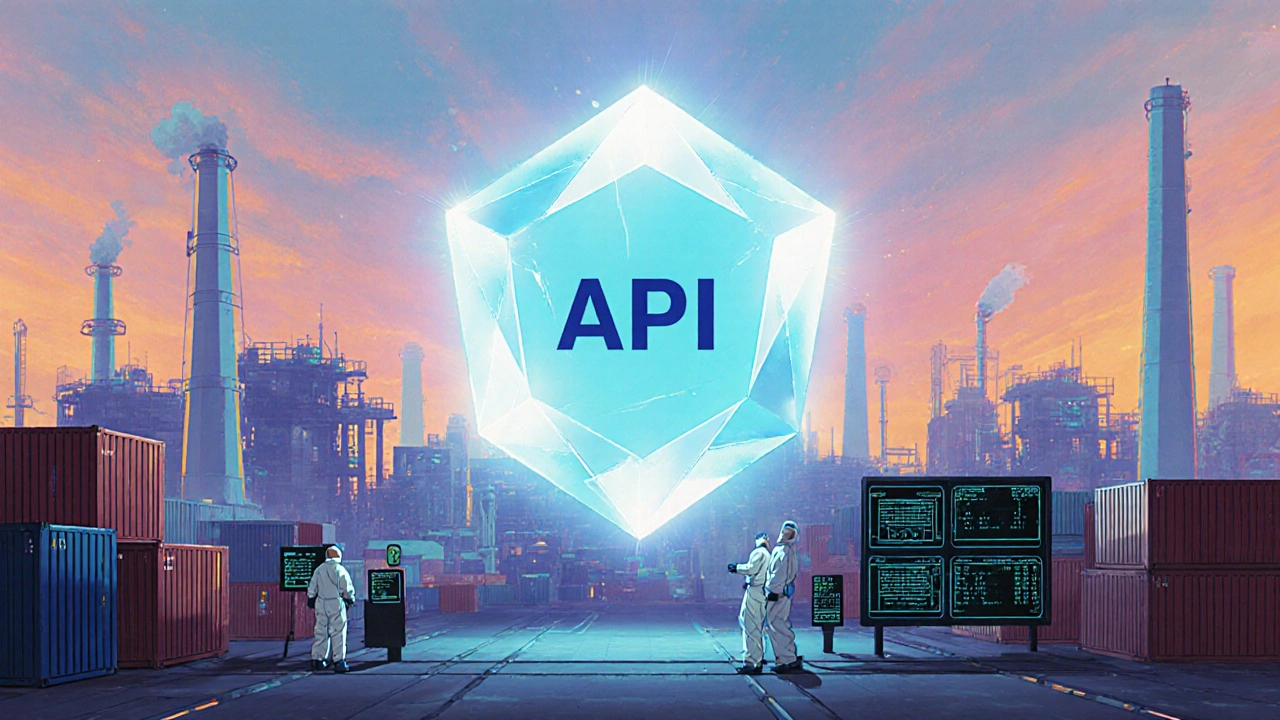Every time you pick up a prescription for a generic drug-whether it’s metformin for diabetes, lisinopril for high blood pressure, or atorvastatin for cholesterol-you’re holding a product that traveled through a complex, global network before landing on your pharmacy shelf. Unlike the flashy marketing behind brand-name drugs, the journey of generics is quiet, complicated, and often hidden from view. But understanding how these medicines get to you matters more than you think. It affects cost, availability, and even safety.
Where It Starts: The Raw Ingredients
It all begins with something most people never think about: Active Pharmaceutical Ingredients, or APIs. These are the actual chemical compounds that make a drug work. For generic drugs, the API is identical to the one in the brand-name version. But here’s the twist: less than 12 percent of API manufacturing happens in the United States. Nearly 90 percent comes from just two countries-China and India. This globalized setup makes sense from a cost perspective. Labor, land, and regulatory costs are lower there. But it also creates risk. When a factory in India shuts down for an FDA inspection, or a port in China gets blocked by weather or politics, hundreds of generic drugs can suddenly disappear from U.S. shelves. During the pandemic, over 170 generic medications faced shortages because of these supply chain hiccups. Manufacturers don’t just buy APIs and start mixing. They must prove to the FDA that their version works exactly like the brand-name drug. That’s done through an Abbreviated New Drug Application, or ANDA. It’s not a shortcut-it’s a rigorous process requiring proof of bioequivalence. The drug must dissolve at the same rate, enter the bloodstream the same way, and deliver the same clinical effect. No room for guesswork.Manufacturing: Clean Rooms and Strict Rules
Once the API arrives, it’s sent to a manufacturing facility that follows Good Manufacturing Practices (GMP). These aren’t suggestions-they’re federal requirements. Every step, from mixing powders to filling capsules, is documented and monitored. Temperature, humidity, even the air quality in the room matter. A single batch can be rejected if a single parameter is off. Quality control happens at multiple stages. Raw materials are tested. In-process samples are checked. Finished products undergo lab analysis. The FDA inspects these facilities, and the number of inspections has more than doubled since 2010-from 248 to 641 in 2022. Still, many plants are overseas, making oversight harder. Experts like Dr. David Ridley from Duke University warn that distance creates blind spots. A factory might pass an inspection one month and cut corners the next. The pressure to keep costs low means many generic manufacturers operate on razor-thin margins. That’s why some use AI and blockchain tools now-to track every vial, every batch, every shipment in real time. These technologies help catch problems early and reduce waste.The Middlemen: Wholesalers and Distributors
After manufacturing, the drugs don’t go straight to pharmacies. They’re sold in bulk to wholesale distributors. Companies like AmerisourceBergen, Cardinal Health, and McKesson handle most of this distribution in the U.S. These wholesalers don’t just store drugs-they negotiate. They buy from manufacturers at a discount, often based on volume or prompt payment terms. Then they sell to pharmacies at a price called the Wholesale Acquisition Cost, or WAC. But here’s the catch: the WAC isn’t what pharmacies actually pay. Most get a further discount off that price, depending on how much they buy. Large chains like CVS or Walgreens get better rates than small independent pharmacies. This layer adds cost, but also stability. Wholesalers maintain large inventories so pharmacies don’t have to. If a drug runs out at one store, the wholesaler can redirect stock from another location. But this system also hides true pricing. You’ll never see the WAC on your receipt. It’s buried in the back-end deals between companies.
How Pharmacies Get Paid: The MAC System
When you pay $4 for a 30-day supply of generic lisinopril, that’s not what the pharmacy paid for it. In fact, they might have bought it for $1.50. So how do they make money? Through reimbursement. This is where Pharmacy Benefit Managers, or PBMs, come in. They’re the middlemen between insurers, pharmacies, and drug manufacturers. They decide how much pharmacies get paid for each generic drug. And here’s the key: they don’t use the brand-name list price. Instead, they use something called Maximum Allowable Cost, or MAC. MAC sets a ceiling for reimbursement based on the active ingredient, strength, and dosage form. For example, every 10 mg tablet of atorvastatin gets the same MAC rate, no matter which company made it. This pushes pharmacies to find the cheapest source possible. If a pharmacy buys a batch for $1.20 and the MAC is $1.40, they make 20 cents. But if the MAC drops to $1.10 and they paid $1.20? They lose money. A 2023 survey by the American Pharmacists Association found that 68 percent of independent pharmacies say MAC rates are often below what they actually pay for the drug. That’s why many independents now band together to negotiate better prices with wholesalers. It’s survival.Who Controls the System: PBMs and Market Power
Three PBMs-CVS Caremark, OptumRX, and Express Scripts-control about 80 percent of the market. They don’t just set MAC rates. They build pharmacy networks. If your pharmacy isn’t in their network, your insurance won’t cover your prescription. That gives them enormous power. Unlike brand-name drugmakers, generic manufacturers rarely negotiate rebates with PBMs. Why? Because there’s no brand loyalty. If a pharmacy can get a cheaper version of the same drug from another maker, they’ll switch. So generic companies compete on price alone. That’s why the top 10 generic manufacturers now control 65 percent of the U.S. market. Smaller players can’t survive the pricing pressure. Meanwhile, PBMs collect rebates from brand-name companies-sometimes billions of dollars a year. But those rebates don’t go to patients. They stay within the system, often increasing the cost of insurance premiums. The result? Generic drugs make up 90 percent of prescriptions but only 23 percent of total drug spending. That sounds good-until you realize the system is designed to keep prices low by squeezing everyone except the PBMs.
What’s Changing Now
The system is under pressure. The Inflation Reduction Act of 2022 started changing how Medicare pays for drugs. The FDA’s 2023 Drug Competition Action Plan aims to speed up generic approvals and reduce shortages. Some states are passing laws to limit PBM practices and force more transparency. Manufacturers are responding. More are diversifying their API sources-building factories in Vietnam, Mexico, or Eastern Europe. Others are investing in AI to predict demand and avoid overstocking. Blockchain pilots are being tested to track drugs from factory to pharmacy, reducing counterfeit risk. But the biggest challenge remains: profitability. Generic manufacturers are making less per pill than ever. If margins keep shrinking, some may exit the market. That could lead to fewer suppliers, more shortages, and higher prices-even for the cheapest drugs.What This Means for You
You might think generic drugs are simple: cheaper, same effect. But behind that simplicity is a fragile, global system under strain. When your prescription is delayed, or you’re told your insurance won’t cover your usual brand, it’s not random. It’s the result of a chain that’s stretched too thin. The good news? Generic drugs still save the U.S. healthcare system over $300 billion a year. The bad news? That savings is being eaten away by hidden costs, opaque pricing, and corporate consolidation. If you’re on long-term generic meds, ask your pharmacist: "Is this the lowest-cost version covered by my plan?" Sometimes, switching to a different manufacturer-same active ingredient, same dose-can cut your cost significantly. And if you see a shortage notice, report it. The more people ask questions, the harder it is for the system to ignore the cracks. The next time you fill a prescription, remember: you’re not just getting a pill. You’re receiving the end product of a global network that’s balancing cost, quality, and survival. And it’s more fragile than it looks.Why are generic drugs so much cheaper than brand-name drugs?
Generic drugs are cheaper because they don’t need to repeat expensive clinical trials. The manufacturer only needs to prove their version works the same as the brand-name drug. They also don’t spend money on advertising or marketing. But even with lower costs, most of the savings don’t reach patients. A big chunk goes to wholesalers, PBMs, and pharmacy networks through complex rebate systems and pricing layers.
Are generic drugs made in the same quality facilities as brand-name drugs?
Yes. Both generic and brand-name drugs must meet the same FDA standards for quality, strength, purity, and safety. The same Good Manufacturing Practices (GMP) apply to both. The difference is in oversight. Many generic manufacturers are overseas, and the FDA inspects fewer of those facilities than domestic ones. But when inspected, they’re held to the same rules. Some generics are even made in the same factories as brand-name drugs.
Why does my pharmacy sometimes give me a different generic version of the same drug?
Because there are often multiple manufacturers making the same generic drug. Pharmacies switch between them based on cost and availability. Your insurance plan may prefer one manufacturer because it offers the lowest price under the Maximum Allowable Cost (MAC) system. If the cheaper version runs out, the pharmacy will switch to the next lowest-cost option-still the same active ingredient, just made by a different company.
Can I ask for a specific generic manufacturer?
Yes, you can ask. But your pharmacy may not be able to honor it if your insurance plan doesn’t cover that version. Some insurers only reimburse for the cheapest option. If you have a reason-like a reaction to a filler in one version-you can request a brand-name drug or ask your doctor to write "Dispense As Written" on the prescription. That can help you get the version you prefer, though you may pay more.
What causes generic drug shortages?
Shortages happen when manufacturers can’t keep up with demand. Common causes include production delays, raw material shortages (especially from overseas), FDA inspections shutting down a factory, or low profit margins causing a company to stop making a drug. Some generics are made by only one or two companies. If one shuts down, there’s no backup. The FDA tracks shortages and tries to alert providers, but it’s often too late by the time the public finds out.
How do I know if my generic drug is safe?
All FDA-approved generics must be bioequivalent to the brand-name drug. That means they deliver the same amount of medicine into your bloodstream at the same rate. You can check the FDA’s list of approved generics online. If you notice a change in how you feel after switching generics, talk to your pharmacist or doctor. It could be a difference in inactive ingredients-like fillers or dyes-not the active drug itself.


Jessica Correa
November 24, 2025 AT 10:37Wow this actually made me think about my blood pressure med in a whole new way
I always just assumed it was just a cheaper version of the brand but never thought about how many countries and people are involved just to get that one pill into my hand
Kinda humbling honestly
manish chaturvedi
November 24, 2025 AT 23:40As someone from India, I can say with confidence that our pharmaceutical industry is one of the most reliable in the world. We produce over 60% of the generic medicines used in the United States. The quality standards are stringent, and the workforce is highly skilled. It is unfortunate that this contribution is often overlooked or mistrusted.
Nikhil Chaurasia
November 25, 2025 AT 08:40My uncle works in a pharma plant in Hyderabad and he says they work 14 hour days to meet US demand
They get paid less than $5 an hour but the pills they make sell for $400 a bottle in America
It’s not just capitalism it’s global exploitation wrapped in a white coat
Michael Fitzpatrick
November 26, 2025 AT 01:57I’ve been on generic atorvastatin for seven years now and I’ve switched manufacturers like five times and never noticed a difference but reading this I realize that’s kind of a miracle
There’s so many points where this whole system could break down and yet it just keeps working
It’s like a silent superhero we never thank
And now they’re being squeezed so hard that some might just quit and then what
We’re all gonna be stuck without our meds because nobody wants to make $0.02 per pill anymore
Shawn Daughhetee
November 27, 2025 AT 07:14my pharmacy gave me a different generic last week and i thought it was a mistake
turns out it was just cheaper
now i know why they always ask if i mind switching
Miruna Alexandru
November 28, 2025 AT 21:36Let’s be clear: the PBM model is a structural parasite. It extracts value from every layer of the supply chain without contributing any value of its own. The fact that these entities control 80% of the market while generating zero therapeutic output is not capitalism-it is rent-seeking at its most grotesque. The 23% of drug spending attributed to generics is a statistical illusion; the real cost is internalized in the form of systemic fragility, workforce exploitation, and consumer ignorance.
Justin Daniel
November 29, 2025 AT 09:23so like… if i buy my metformin from the cheapest generic maker and it works fine… why do i care who made it?
also why does everyone act like this is a secret? it’s been like this for 20 years lol
ann smith
November 30, 2025 AT 16:53This is such an important topic! 💙
Thank you for breaking it down so clearly.
So many people don’t realize how much goes into those little pills.
Let’s keep pushing for transparency and fair pricing - we all deserve safe, affordable medicine.
❤️
Julie Pulvino
December 2, 2025 AT 05:04My mom’s been on lisinopril for 15 years and she’s switched generics like 8 times
never had an issue but now i’m paranoid
also why does my pharmacy never tell me which one they’re giving me?
is that illegal or just shady
Danny Nicholls
December 3, 2025 AT 00:21so i just found out my cheap generic cholesterol pill is made in china and i’m kinda freaked out
but then i remembered my phone is made there too and it works fine
so maybe it’s okay?
also why do i keep seeing ads for brand name stuff if generics are the same??
Rahul Kanakarajan
December 4, 2025 AT 20:07Of course the U.S. outsources its pharmaceuticals to developing nations - because why invest in domestic infrastructure when you can exploit cheap labor and weak regulations? This isn’t globalization, it’s colonialism with pill bottles. And now you’re surprised when shortages happen? You built this house on sand.
New Yorkers
December 5, 2025 AT 08:05Y’all act like this is news? In NYC we’ve been getting different generics since 2012. One time I got a pill that looked like a tiny green dinosaur. I asked the pharmacist. She said, "It’s the same medicine, honey. Just cheaper." I took it. Didn’t die. Moved on.
luke young
December 5, 2025 AT 19:55Really appreciate this breakdown
especially the part about MAC rates
my local pharmacy told me they’re losing money on some generics and it makes sense now
maybe we need to start supporting independent pharmacies more
james lucas
December 5, 2025 AT 23:04Man I never thought about how much the wholesalers and PBMs make off this
I just thought the drug companies were the bad guys
but now I see it’s more like a pyramid scheme where the pharmacist is at the bottom trying to make 20 cents on a $4 pill while the middlemen get rich
and the FDA is playing whack-a-mole with factories in India
we need to fix this before someone dies because a factory shut down for a week and no one noticed